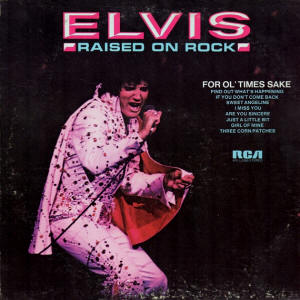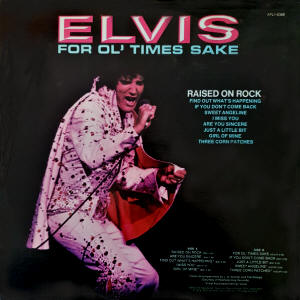Verdict
This album could have been a highlight, but even the best musicians were not able to save the bored and over-medicated artist. Nevertheless the album isn't as bad as its reputation and includes some cool stuff.
![]()
(C) RCA Records
The ultimate site about the king of the analogue age


In October 1973 RCA released "Raised On Rock / For Ol' Times Sake". With sales of 200,000 units the album entered the "Hot LPs Chart" on November 13th, had a run of 13 weeks and peaked at number 50. Globally the album sold a million copies, which equals 150 million paid streams of the complete album or 1.5 billion paid streams of individual tracks. "Elvis Sings The Wonderful World Of Christmas" and "Elvis As Recorded At Madison Square Garden" had sold five million copies each, "Aloha From Hawaii Via Satellite" even had moved 10 million copies. Studio albums like "Elvis Now", "Elvis" or "Raised On Rock / For Ol' Times Sake" just sold a million units, which was 20% of the "Christmas" and "MSG" albums and 10% of "Aloha". Live records and seasonal music sold very well, but nobody seemed to care for the king's recent work anymore. Even being barely 39 years old and constantly releasing new material, Elvis had become a catalogue artist, an artefact of the past.
In 2016 the complete Presley catalogue was restored and remastered by Vic Anesini for a boxed set of 60 compact discs called "The Album Collection". Sony Music Entertainment provides the streaming platforms with the same versions of the individual albums (some of them offering bonus tracks), albeit in 24 bit/90 khz flac. That means, if the platform of your choice supports high resolution audio, you can enjoy the tracks in the same quality Sony used to scan and master them. On Spotify, which has a market share of approximately 30% and is the only platform that publishes streaming figures, "Raised On Rock / For Ol' Times Sake" accumulates 8.4 million streams. So the album remaines as unpopular as it ever was.
The front and back cover of the album was (more or less) identical, on one side the album was called "Raised On Rock", on the other side it was named "For Ol' Times Sake". The photo was taken in Las Vegas in early 1973.
In the course of the buyout deal Elvis had signed a new seven years contract with RCA Records. The king had to deliver two longplayers and four singles (28 masters) per year and was paid per sold unit. The label guaranteed an annual minimum payment of 500,000 USD. Using our rough factor of 15, this would be 7.5 million USD today. Because Elvis hadn't recorded anything until June, RCA undertook the unusual step to remind the singer of his contractual obligations in black and white. Unambiguously RCA demanded the production of a pop album, a religious album and two separate singles as early as July 1973. Felton Jarvis booked the Stax Studios in Memphis, which were very trendy at the time. For Elvis the only reason to record there was the fact, that the studios were located just a few miles from his Graceland Mansion. The recording facility was booked between July 20th and 25th. The sessions were produced by Felton Jarvis and engineered by Al Pachucki. Until July 23rd the band consisted of James Burton (guitar), Reggie Young (guitar), Tommy Cogbill (bass) and Ronnie Tutt (drums). On the last two days Bobby Manual (guitar), Johnny Christopher (guitar), Donald Dunn (bass) and Al Jackson (drums) took over. Charlie Hodge (guitar), Jerry Carrigan (drums), Bobby Wood (piano) and Bobby Emmons (organ) were there from July 20th to 25th. The same applied to J.D. Sumner & The Stamps (Ed Enoch, Bill Baize, Donnie Sumner and David Rowland) as well as Kathy Westmoreland, Jeannie Greene and Mary & Ginger Holladay. The sessions were ill-fated right from the start. On the first day Elvis didn't show up at all, on the other days he was noticeably medicated. When his personal microphone was stolen, he simply left the studio and never returned. It was obvious, that the king was completely desinterested in didn't want to record at all. People like Bobby Wood, who hadn't seen him since the famous sessions at American Sound Studio in 1969, where shocked about Elvis' look and behavior. RCA had expected 24 new masters, but Elvis had delivered just nine. Not even enough to fill an album. So mobile recording equipment was installed in the king's house in Palm Springs. On September 22nd and 23rd Elvis recorded additonal material with James Burton (guitar), Charlie Hodge (guitar), Thomas Hensley (bass) and Donnie Sumner (piano). The harmony vocals were provided by Mr. Sumner, Tim Baty and Sherrill Nielsen. On September 28th Felton Jarvis added strings and horns at RCA Studio A in Hollywood/California. The result was a ten-track album with a running time of 27:28 minutes.
In 2007 Follow That Dream Records released a collector's edition of "Raised On Rock / For Ol' Times Sake". For a review, tap HERE.
Raised On Rock
The track had been released on a single in early September, but hadn't made it past number 41 of the "Hot 100". Elvis recorded "Raised On Rock" on July 23, 1973 within ten takes. Mark James, the writer of the song, tells us about his youth and about being raised on rock'n'roll music. It is strange to hear Elvis Presley sing these lyrics, because it's simply not believable, that he was raised on a music, he once had been the king of. And it's even stranger to hear him mentioning a song from the 1960s and a song, that was his own hit record. Besides that Elvis sounds quite tired, it's almost impossible to connect his vocals to the good ole' rock'n'roll. Musically I would regard "Raised On Rock" to be well written, uptempo radio-pop. I like the driving beat, which is provided by two drummers.
Are You SincereElvis taped "Are You Sincere" on September 23, 1973 in Palm Springs and needed four attempts to get it right. Once again he sounds tired, but this time it fits the song perfectly. The narrator wants his lady to assure her love for him, but he sounds as if he knew the answer beforehand. Elvis performs the ballad very well, the original was released in 1958 by Andy Williams. The king must have liked the song instantly, because he taped it at home as early as December of the same year.
Find Out What's HappeningThis is another cover version, this time written by Jerry Crutchfield and first released in 1964 by The Spidells. The singer threatens to end the relationship, if his lady doesn't reconsider her behavior towards him. Once again Elvis sounds fatigued, which in this case may be regarded as a stylistic element. In total Elvis recorded nine takes of "Find Out What's Happening", before he turned his attention to "I've Got A Thing About You Baby" and gave a much more vital impression.
I Miss YouOn September 23, 1973 Elvis recorded this ballad about a lost love and invested 15 takes to get it right. The king sings with much emotion, but doesn't slip down into kitsch. It's a fine performance of a solid song, written by Donnie Sumner.
Girl Of MineThis "rock to and fro together country song" was written by Barry Mason and Les Reed and released in 1972 by Engelbert Humperdinck. Elvis covered it on July 24, 1973 within 11 attempts. This lightweight affair is performed well by the band, but the king lacks zest and simply sounds tired.
For Ol' Times SakeOf course the first song of the b-side of this album is "For Ol' Times Sake". It was written by Tony Joe White, who was also the first to record it. Elvis followed him on July 23, 1973 and delivered the ultimate version of the song with take number eight. The narrator is left by his wife and asks her to allow him to take her in his arms for one last time. The melody is sad, the arrangement is sparse and Elvis sounds honestly sad. Today "For Ol' Times Sake" often is overlooked, but for me this is one of the king's greatest ballads.
If You Don't Come BackThis one also is a true gem. James Burton's wah-wah effect, the classy vocals of Westmoreland, Greene and Holladay and a dazed sounding Elvis. The whole thing sounds extremely funky, very atmospheric and absolutely contemporary (from 1973's point of view). I can be estimated, that the king really was overmedicated, but here his condition matched the song. It's strange, that "If You Don't Come Back" sounds so 1970ish, because the Leiber/Stoller song was first released as early as 1963 by The Drifters.
Just A Little BitThe singer tries to woo a lady, but he sounds so tired and powerless, that the success is doubtful. Elvis obviously didn't care for "Just A Little Bit" and approved the second take for release. It's a pity, that the king wasn't interested in delivering a good performance, because his cover version is arranged a lot better than the original by Tiny Topsy (released in 1959). By the way: The song was written by John Thornton, Piney Brown, Ralph Blass and Earl Washington.
Sweet AngelineIn contrast to "Just A Little Bit" I like this ballad very much. The narrator tells his feelings to a lady, with whom he had a heartfelt, but not long-lasting relationship. He advises her, to be thankful for the time they had instead of being sad. Elvis doesn't sound chauvinistic, but wistful and also a bit tired. The music track including the harmony vocals were recorded on July 25, 1973 at the Stax Studios in Memphis. Elvis added his part on September 22nd in Palm Springs. "Sweet Angeline" was written by Chris Arnold, David Martin and Geoff Morrow, who also recorded it in 1971.
Three Corn PatchesThe rocker was written by Jerry Leiber and Mike Stoller and recorded for the first time in 1973 by T-Bone Walker. Elvis followed him on July 21, 1973, but could not provide the energy a song like this needs. On the original reels he can be heared saying "I can't kick that motherfucker". Unfortunately the master proves, that he was right.
This album could have been a highlight, but even the best musicians were not able to save the bored and over-medicated artist. Nevertheless the album isn't as bad as its reputation and includes some cool stuff.
![]()
(C) RCA Records